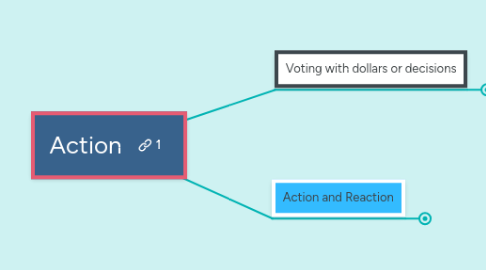
1. Voting with dollars or decisions
1.1. Voting with dollars is an analogy that refers to the impact of consumer choice on producers actions through the flow of consumer payments to the producer.
1.1.1. In economic terms, if you (and many other people as well) start choosing to only buy environmentally friendly products and services, then the demand for said products and services will increase, forcing the producers to increase the supply to meet the demand. Your individual decision likely will not completely change the economic balance, but as with voting, it contributes, hence the analogy (Green America).
1.1.2. This analogy with voting - and the significance of individual influence- applies to regular decision making as well. How much energy your home uses per month for example, how and how often you travel, how much water your household uses, how you treat your land, what career you pursue, etc.
1.2. Independent actions can be used as a summary of Global - or at least larger scale- actions.
2. Action and Reaction
2.1. Chemistry
2.1.1. Catalysts
2.1.1.1. Catalysts reduce the amount of energy necessary for two substances to react: a catalyst lowers activation energy.
2.1.1.2. Catalysts in a non-chemistry context are like the exciting incident in the hero’s journey: they prompt action or a response to an action - setting something in motion.
2.1.2. Equilibriums
2.1.2.1. Le Chatlier’s principle
2.1.2.1.1. If one side of a chemical equilibrium is altered, then the equilibrium will shift to counteract the effects of the alteration: addition of heat, change in chemical proportions, etc.
2.2. “For every action, there is an equal and opposite reaction” (Newton’s Third law).
2.2.1. Applicable in both a physical sense, and a philosophical lens, this quote exemplifies the complex relationship between an action and a reaction.
2.2.1.1. See Action, Effect, Reaction, & Significance.
2.3. Action, Effect, Reaction, & Significance
2.3.1. Actions can act as catalysts for reactions— someone can react to an action.
2.3.2. Reactions can also act as catalysts for additional reactions - someone can react to a reaction.
2.3.3. With this in mind, there is little distinction between action and reaction, other than action usually implies agency, while reaction implies instinct.
2.3.3.1. Shelving reaction, action can create effects. These effects can be reactions, or just changes in the physical world. But the effects can act as catalysts for further action.
2.3.3.1.1. If the effects are significant for someone, then they could act as a catalyst for action.
2.3.3.1.2. Take this example: Someone taking a test is an action. The result or grade could be considered the effect. If the person is dissatisfied with the grade, then the poor grade could act as a catalyst that promotes the person to study more for the next test. And the result of the second test could promote additional action, and so on and so forth.
2.3.3.1.3. Action and significance can form a loop or a cycle: the effects of actions can be significant, but effects can also prompt another action, which could have significant effect, which prompts more action, etc.

